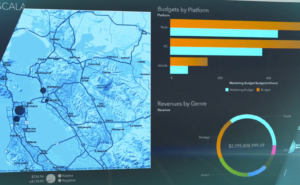
SAS Previews Upcoming Enhancements to Viya Platform

Neural network interpretability, integration with open source analytic libraries, and greater mobility within SAS’s product suite are among the capabilities that are coming to the SAS Viya platform later this quarter.
SAS used its Global Forum this week in Denver, Colorado to showcase changes coming to Viya, the flagship analytic platform unveiled a year-and-a-half ago to take SAS products and SAS customers into the future of analytics.
Jonathan Wexler, principal product manager of analytics at the North Carolina analytics giant, provided Datanami with a preview of the new features, which are slated to be delivered in June.
First and foremost, the various SAS products that compose the Viya suite – from Data Preparation and Model Manager to Visual Data Mining and Machine Learning (VDMML) and Event Stream Processing — now feature a level of cross-product integration that was absent before.
“You’re going to see that our analytics suite is truly integrated,” Wexler says. “They look and feel like they came from the same company.”
SAS customers who use the latest software will also benefit from freedom of movement within the suite. So customers who start with a relatively simple task, such as preparing or visualizing data, and then avail themselves of more sophisticated SAS capabilities – like building machine learning models and even deploying them in a streaming analytic pipeline — can now easily pick up the work at any point in between.
Wexler calls this “going from right to left” along the analytic continuum, which naturally starts out on the left with relatively simple tasks and gets progressively more complex the further right one travels.
“Once you got into the pipeline, you couldn’t really go back, which we all know is part of the trick here,” he explains. “Once you’ve gone into the automation phase, you can now go back to the interactive phase. You can work your way backward, all within in that environment, without moving data.”

SAS describes Viya as an “insight-generating, burst-processing, fast-as-lightening, gotta-know-right-now analytics platform that meets all data challenges and serves anyone — executives, data scientists, domain experts, analysts, developers.”
SAS is also making it easier for customers on older releases of SAS products, most notably Enterprise Miner, to bring their work forward into the new Viya world.
“We’re extending out the environment so existing SAS customers can transition to this new environment by bringing along and accessing their existing work,” Wexler says. “If you have a favorite technique – some obscure stats technique, for example — you can call upon that in the Viya environment. What we’re trying to do is open the environment up for the entire SAS user base.”
The upcoming enhancements to Viya will give users better integration with open source tools, such as the popular Python- and R-based libraries that have become popular among data scientist and analysts over the past several years. Specifically, SAS will allow external packages to patriciate in model tournaments that its customers hold to determine the best models to put into production.
“You can now bring open source external packages, like Scikit-learn, into the Viya environment and you can compare and contrast those models,” Wexler says. “So you can run the open source package against data that you’re massaging and preparing in VDMML. You can have a tournament with the open source packages and normal SAS models.”
SAS has an interesting relationship with open source software. The company has a long and successful history of developing analytics software that is distributed with a traditional proprietary license. However, we’re currently witnessing a blossoming of open source alternatives, including the proliferation of many R and Python-based analytics libraries, and SAS customers, which are some of the largest organizations on the planet, naturally want to partake of this progress. But the trick is utilizing open source enhancements without ditching SAS or abandoning the work they’ve done with those proprietary tools.
To that end, the Viya architecture now sports a node that’s dedicated open source where users can run Python and R packages. It’s worth noting that while the SAS software runs in-memory and in a distributed, multi-threaded manner, the Python and R stuff won’t be quite as fast.
“Inherently, the open source packages don’t run in the in-memory environment. They just don’t. They’re single-threaded. They’re at the mercy of your R or Python installation on your server. They’re going to use that runtime,” Wexler says. “We’re not going to parallelize some of the open source packages. I can’t say tomorrow that won’t change, but as of now, the plan” is to support the packages in a non-parallel manner.
A key aspect of Viya is support for deep learning. Since it launched in 2016, Viya users have built neural networks that can be trained upon huge swaths of data. Now SAS is adding an interpretability layer that uses emerging techniques, such as Local Interpretable Model-Agnostic Explanations (LIME) and impact, confidence and ease (ICE), to help users justify the recommendations and predictions that the AI makes.
“A lot of these techniques are inherently black box, so we’ve put a concerted effort throughout the suite to use specific techniques like LIME and ICE” to help users interpret the models, Wexler says. “So throughout the suite, if you’re a regulator and you want to understand what is the effect of this particular variable, as opposed to showing them a neural network, which nobody is going to be able to interpret, we’re providing these visuals.”
SAS says more than 30,000 attendees were expected at SAS Global Forum this week. In addition to the new software, the company announced a new anti-fraud division that will use AI and advanced analytics, as well as the results of a survey that suggests that consumers are more comfortable with AI in healthcare.
Related Items:
SAS Goes Back to the Future of Cognitive Computing with Viya
Python Eats Into R as SAS Dominance Fades




























